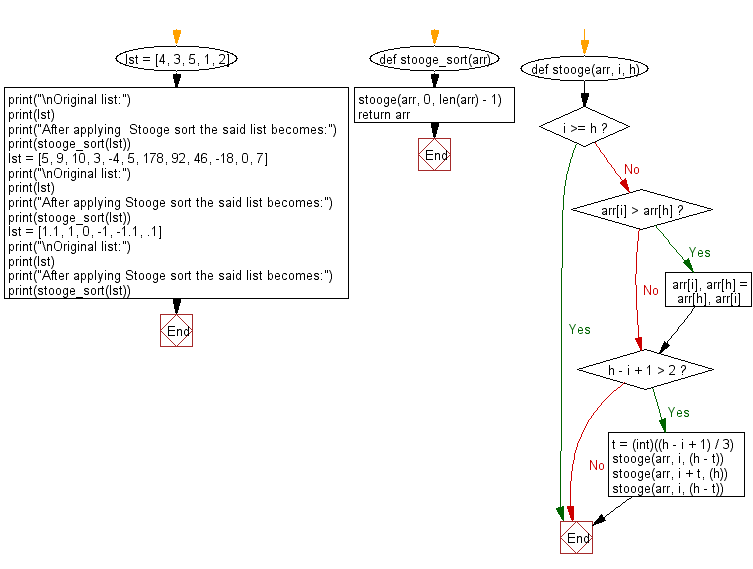Python: Sort unsorted numbers using Stooge sort
27. Stooge Sort
Write a Python program to sort unsorted numbers using Stooge sort.
Stooge sort is a recursive sorting algorithm. It is notable for its exceptionally bad time complexity of O(nlog 3 / log 1.5 ) = O(n2.7095...). The running time of the algorithm is thus slower compared to reasonable sorting algorithms, and is slower than Bubble sort, a canonical example of a fairly inefficient sort. It is however more efficient than Slowsort. The name comes from The Three Stooges.
The algorithm is defined as follows:
• If the value at the start is larger than the value at the end, swap them.
• If there are 3 or more elements in the list, then:
Stooge sort the initial 2/3 of the list
Stooge sort the final 2/3 of the list
Sample Solution:
Python Code:
#Ref.https://bit.ly/3pk7iPH
def stooge_sort(arr):
stooge(arr, 0, len(arr) - 1)
return arr
def stooge(arr, i, h):
if i >= h:
return
# If first element is smaller than the last then swap them
if arr[i] > arr[h]:
arr[i], arr[h] = arr[h], arr[i]
# If there are more than 2 elements in the array
if h - i + 1 > 2:
t = (int)((h - i + 1) / 3)
# Recursively sort first 2/3 elements
stooge(arr, i, (h - t))
# Recursively sort last 2/3 elements
stooge(arr, i + t, (h))
# Recursively sort first 2/3 elements
stooge(arr, i, (h - t))
lst = [4, 3, 5, 1, 2]
print("\nOriginal list:")
print(lst)
print("After applying Stooge sort the said list becomes:")
print(stooge_sort(lst))
lst = [5, 9, 10, 3, -4, 5, 178, 92, 46, -18, 0, 7]
print("\nOriginal list:")
print(lst)
print("After applying Stooge sort the said list becomes:")
print(stooge_sort(lst))
lst = [1.1, 1, 0, -1, -1.1, .1]
print("\nOriginal list:")
print(lst)
print("After applying Stooge sort the said list becomes:")
print(stooge_sort(lst))
Sample Output:
Original list: [4, 3, 5, 1, 2] After applying Stooge sort the said list becomes: [1, 2, 3, 4, 5] Original list: [5, 9, 10, 3, -4, 5, 178, 92, 46, -18, 0, 7] After applying Stooge sort the said list becomes: [-18, -4, 0, 3, 5, 5, 7, 9, 10, 46, 92, 178] Original list: [1.1, 1, 0, -1, -1.1, 0.1] After applying Stooge sort the said list becomes: [-1.1, -1, 0, 0.1, 1, 1.1]
Flowchart:

For more Practice: Solve these Related Problems:
- Write a Python program to implement stooge sort and count the number of recursive calls made during the sort.
- Write a Python script to apply stooge sort on a small list and print the list after every recursive call.
- Write a Python program to implement stooge sort and then analyze its worst-case time complexity with sample inputs.
- Write a Python function to perform stooge sort and compare its result with bubble sort on the same dataset.
Go to:
Previous: Write a Python program to sort unsorted numbers using Strand sort.
Next: Write a Python program to sort unsorted numbers using Recursive Quick Sort.
Python Code Editor:
Contribute your code and comments through Disqus.
What is the difficulty level of this exercise?
Test your Programming skills with w3resource's quiz.
